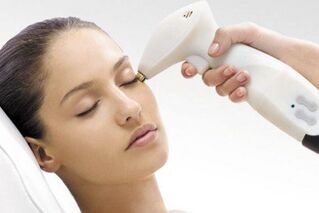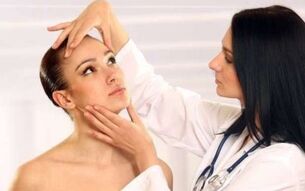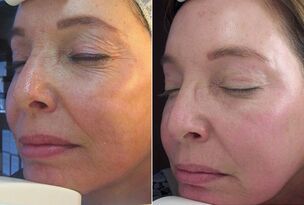For a long time, plastic surgery was the only way to rejuvenate. But this method has many contraindications, and is also associated with certain health risks, therefore, not all of them can be solved with the help of surgical intervention. Fortunately, modern aesthetic medicine offers many less harmful anti-aging treatments. One of the suitable alternatives to plastic surgery is laser facelift.
Fortunately, modern aesthetic medicine offers many less harmful anti-aging treatments. One of the suitable alternatives to plastic surgery is laser facelift.
What is it?
Laser lifting is a modern non-surgical method of combating age-related skin changes. This technique aims to improve the quality of the skin. It stimulates the regenerative process (cell renewal), improves blood circulation in the area of laser exposure, which helps smooth wrinkles.
During the procedure, natural collagen is actively produced, which provides tissue elasticity. This is especially important for areas with fine skin, where various methods of rejuvenation are unacceptable.
The difference between laser lifting and other methods of plastic and facelift is that this procedure does not involve surgery. The operation is performed using special equipment for laser therapy. Light rays penetrate the skin and act on weak and dead cells.
Laser facelifts can be done for women and men between the ages of 18 and 70. Often, the need for this procedure arises after 30 years, when the first signs of skin aging appear.
Usually, cosmetologists prescribe a laser lifting course, as one session is not enough. Achieving maximum effect is possible 3 months after the last procedure is performed. With proper skin care, the rejuvenating effect can last around three years.
Instructions for the procedure
Laser lift will help solve a large number of problems. This procedure is indicated for patients with the following problems:

- sagging eyelid skin;
- expressions and wrinkles of age;
- dark circles and bags under the eyes;
- pronounced nasolabial folds;
- acne scars;
- small scars;
- enlarged pores;
- unhealthy skin;
- presence of age spots;
- vascular network;
- sagging chin sagging;
- neck wrinkles.
Contraindications
Laser lifting is contraindicated by the following factors:
- acute inflammatory and infectious diseases;
- any oncological diseases;
- chronic diseases;
- various blood diseases;
- pregnancy and lactation;
- HIV infection;
- diabetes mellitus;
- mental disorders;
- diseases associated with the thyroid gland;
- epilepsy;
- hepatitis;
- skin diseases of various kinds;
- bad blood clotting.
Natural surface type
Currently, in cosmetology practice, laser ablation is performed using two technologies: ablative and non-ablative. They are different because each uses a different type of laser.
Ablative
Ablative is the most widespread laser lifting technology.The effects of light beam are directed to the outer layer of the epidermis, which is in constant contact with the environment.
Under laser action, the dead skin layer gradually evaporates. Fiftift ablative trauma, but guarantees results.
Not ablative
This technique involves laser beams penetrating deep into the skin, stimulating the synthesis of collagen and elastin. The top layer of skin remains intact. This laser removal method helps improve tissue tone, resulting in an improvement of the face.
Unlike ablative tightening, also called "burning", non-ablative techniques are considered softer. The lifting method should not be used on sensitive skin areas - the eyelids and the area around the eyes.
This technology is not very popular, as many cosmetologists doubt its effectiveness.
Ready for the procedure
Before the laser lifting procedure, it is important to visit a beautician who will assess the general condition of the skin and draw conclusions about the suitability of the operation.To reduce the risk of side effects, you need to pass the following tests:
- general analysis of blood and urine;
- x-ray chest;
- syphilis test;
- HIV test;
- cardiac cardiogram.
Doctors should also know all the diseases that patients suffer from.
About two weeks before the session, there are simple rules to follow:
- refuses to visit baths, saunas and solariums, and also does not sunbathe;
- do not consume alcoholic beverages;
- take antiviral medication in the course (only as prescribed by a cosmetologist).
It is not recommended to drink coffee and energy drinks on the day of the session.
How is the facelift done?
Laser lifting techniques are relatively simple:

- The patient puts a medical hat or bandage over his head to remove his hair and lie down on the couch.
- Next, the doctor prepares the skin: removes makeup residue and oily secretions.
- Then the cooling gel is applied to the face. For patients with very sensitive skin, anesthetic creams are used.
- The procedure is painful. For this reason, it is often done under local or general anesthesia.
- During the session, the patient's eyes must be covered, until they wear sunglasses. After completing the setup steps, the laser lifting process can begin.
- The doctor runs a special device with a hand tool on the patient's face, observes the problem area and overcomes it carefully.
Different tools are used depending on the procedure used. This differs in exposure technology and beam penetration depth.
There are two types of lasers: cold and hot. For facelifts, carbon dioxide, erbium or laser diodes can be used.
- Laser carbon dioxide is the strongest. Helps remove any wrinkles and scars.
- Erbium is effective against the first signs of aging. Has a mild effect on the skin surface.
- Deep skin rejuvenation is done using a diode laser. Light rays can penetrate 5-50 mm inwards.
Ablative rejuvenation is performed with a carbon dioxide laser. Under the influence of heat, dead cells gradually evaporate, and eventually new and young skin is left.
Erbium lasers and diodes are used for non-ablative facelifts.The action of light beams is directed to the inner layers of the skin. The process of collagen production is triggered in connective tissue, contributing to the tightening and rejuvenation of the skin.
After the procedure, the beautician treats the patient's face with antiseptic, then uses a soothing cream or mask.
Before and after photos
Next in the photo you can see the results before and after the procedure.

Recovery
The duration of the recovery period depends on the technology of the procedure.The stronger the effect, the longer it takes for full skin recovery.
During recovery, redness, swelling, and hypersensitivity are common. This is a permissible consequence of laser removal and should not be a concern. After a few days, the symptoms will go away on their own.
After laser lifting, the skin needs gentle care. Patients must strictly adhere to the doctor's recommendations and adhere to the following rules:
- do not visit swimming pools, saunas, baths and beaches for two to three months;
- be sure to use sunscreen when going out;
- do not use decorative cosmetics until the skin is completely restored;
- try to touch your face with your hands as small as possible;
- does not include face massage;
- let go of bad habits;
- follow a healthy diet;
- drink plenty of fluids.
With proper care and adherence to makeup artist instructions, tightening results can be seen after seven days. The skin will be firmer and healthier, wrinkles and scars will disappear. Oval face will be flat shape and clear outline. Changes are usually not visible immediately after the procedure.
Complications
Laser facelift is considered a safe rejuvenation method. During the procedure, there is no direct contact with the skin with the equipment, so the risk of infection with various diseases can be minimized. Complications can arise in two cases: inadequate level of professionalism of the cosmetologist and the patient's non-compliance with the rules of care.
The most dangerous side effects are:
- herpes;
- increased skin pigmentation;
- whiteheads;
- Scar formation (in case of tearing of the formed crust).
























































